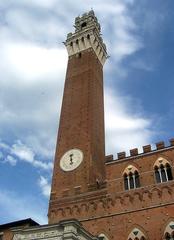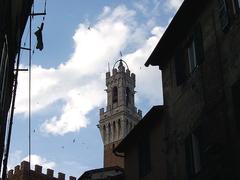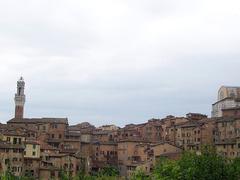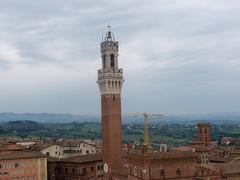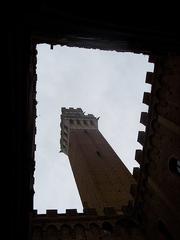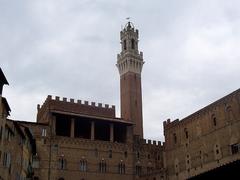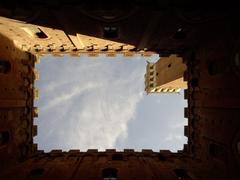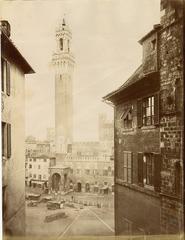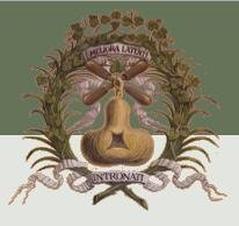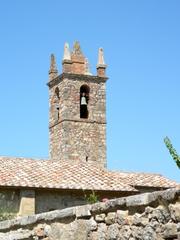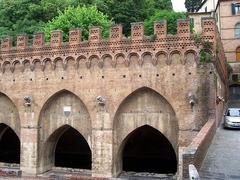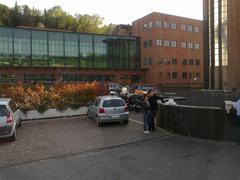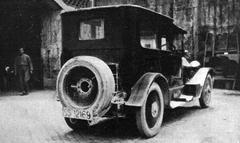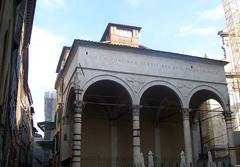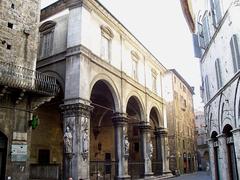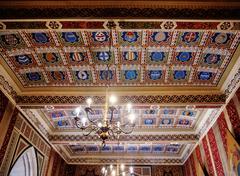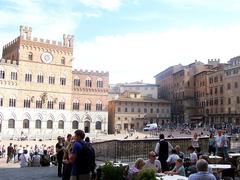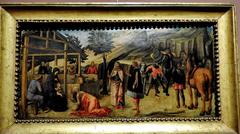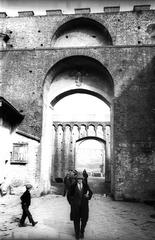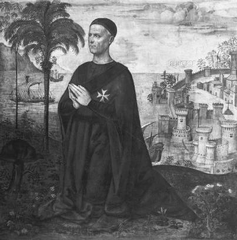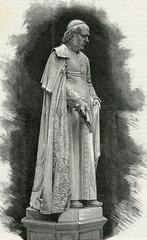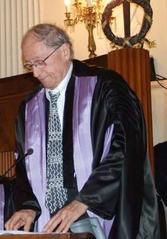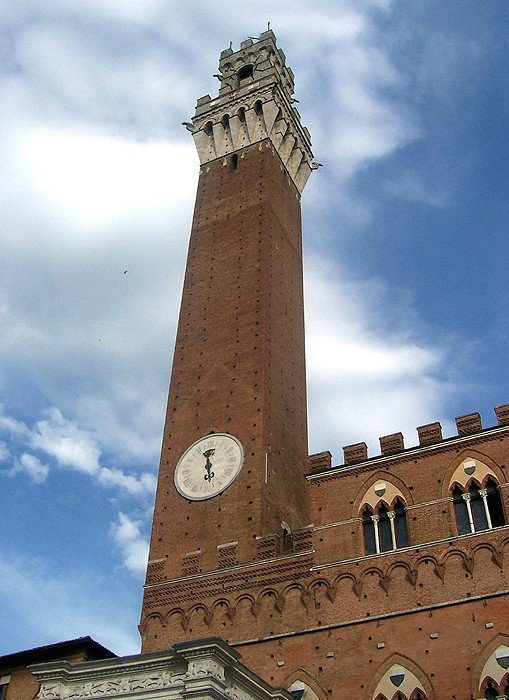
Visiting Hours, Tickets, and Historical Insights of Palazzo Pubblico, Siena
Date: 19/07/2024
Introduction
The Palazzo Pubblico, also known as the Town Hall, is a historical and architectural masterpiece located in the heart of Siena, Italy. Constructed between 1297 and the early 14th century, it served as the seat of the Republic of Siena’s government and stands as a testament to the city’s rich medieval heritage and artistic splendor (Siena Tourism). With its elegant Gothic façade and the towering Torre del Mangia, the Palazzo Pubblico is not only a symbol of Siena’s political and cultural legacy but also a treasure trove of artistic masterpieces, including frescoes by renowned artists such as Ambrogio Lorenzetti and Simone Martini (Khan Academy).
This comprehensive guide aims to provide visitors with essential information about the Palazzo Pubblico, including its history, architectural features, visitor tips, and nearby attractions. Whether you are a history enthusiast, an art lover, or a tourist exploring the historical sites of Siena, this guide will help you make the most of your visit to this remarkable landmark.
Table of Contents
- Introduction
- Origins and Construction
- Architectural Features
- Frescoes and Artistic Significance
- Political and Historical Context
- The Torre del Mangia
- Visitor Information
- Cultural and Touristic Importance
- Nearby Attractions
- Preservation and Conservation Efforts
- Conclusion
- FAQs
Origins and Construction
The construction of the Palazzo Pubblico began in 1297 and was completed in the early 14th century. It was designed to serve as the seat of the Republic of Siena’s government, housing the Podestà (chief magistrate) and the Council of Nine, the governing body of the city. The architectural style of the Palazzo Pubblico is predominantly Gothic, characterized by its elegant façade and the iconic Torre del Mangia, which was added between 1338 and 1348 (Siena Tourism).
Architectural Features
The Palazzo Pubblico is renowned for its distinctive architectural features. The façade is constructed from brick and travertine, a common material in Sienese architecture. The building’s symmetry and the use of pointed arches and mullioned windows are typical of the Gothic style. The Torre del Mangia, standing at 102 meters, was one of the tallest secular towers in medieval Italy and offers panoramic views of Siena and the surrounding Tuscan countryside (Italy Heaven).
Frescoes and Artistic Significance
One of the most significant aspects of the Palazzo Pubblico is its interior decoration, particularly the frescoes that adorn its walls. The most famous of these is the series of frescoes by Ambrogio Lorenzetti, known as the “Allegory of Good and Bad Government,” painted between 1338 and 1339. These frescoes are located in the Sala dei Nove (Hall of Nine) and are considered masterpieces of early Renaissance art. They depict the effects of good and bad governance on the city and countryside, serving as a visual representation of the political philosophy of the time (Khan Academy).
Political and Historical Context
The Palazzo Pubblico played a central role in the political life of Siena during the Middle Ages and the Renaissance. The Republic of Siena was an independent city-state from the 12th century until 1555, when it was conquered by the Duchy of Florence. During its independence, Siena was governed by various councils, with the Council of Nine being the most notable. This council was responsible for the administration of the city and the construction of many of its public buildings, including the Palazzo Pubblico (Encyclopaedia Britannica).
The Torre del Mangia
The Torre del Mangia, an integral part of the Palazzo Pubblico, was constructed to symbolize the power and prosperity of Siena. The tower’s name, which translates to “Tower of the Eater,” is derived from its first bell-ringer, Giovanni di Balduccio, nicknamed “Mangiaguadagni” (profit eater) due to his reputed gluttony. The tower’s height was intended to rival that of the cathedral’s campanile, reflecting the secular power of the city government in contrast to the religious authority of the church (Visit Tuscany).
Visitor Information
Tickets and Visiting Hours
The Palazzo Pubblico is open to the public, and visitors can purchase tickets to explore its historic rooms and museum. The Museo Civico, housed within the Palazzo, offers a collection of important works of art from the Sienese school. Tickets can be purchased at the entrance or online, with prices varying depending on the type of visit. The Palazzo is typically open from 10:00 AM to 6:00 PM, but it is advisable to check the official Museo Civico Siena website for the most current opening hours and ticket prices.
Travel Tips
When visiting the Palazzo Pubblico, wear comfortable shoes as the tour involves walking through several rooms and climbing the Torre del Mangia for breathtaking views. Photography is allowed in most areas, but be mindful of the signs indicating restricted areas. Guided tours are available and highly recommended for a deeper understanding of the history and art.
Cultural and Touristic Importance
The Palazzo Pubblico is a major tourist attraction in Siena, drawing visitors from around the world. Its historical and artistic significance, combined with its stunning architecture, make it a must-visit destination. The building is also a focal point during the Palio di Siena, a traditional horse race held twice a year in the Piazza del Campo, the square in front of the Palazzo. The Palio is a significant cultural event that dates back to the Middle Ages and is a testament to Siena’s rich heritage (Palio di Siena).
Nearby Attractions
While in Siena, visitors should also explore nearby attractions such as the Siena Cathedral, the Baptistery of San Giovanni, and the Museo dell’Opera del Duomo. These sites offer additional insights into the rich history and culture of Siena.
Preservation and Conservation Efforts
Preserving the Palazzo Pubblico and its artworks is a priority for the city of Siena. Conservation efforts are ongoing to maintain the structural integrity of the building and to protect its valuable frescoes and other artworks. These efforts are crucial in ensuring that future generations can continue to appreciate the historical and cultural significance of this iconic landmark (Siena Municipality).
Conclusion
In summary, the Palazzo Pubblico is not only a symbol of Siena’s historical and political legacy but also a treasure trove of artistic masterpieces. Its significance extends beyond its original function as a government building, encompassing its role as a cultural and touristic landmark that continues to captivate visitors with its beauty and historical depth. Be sure to include the Palazzo Pubblico in your itinerary when visiting Siena to fully experience its rich heritage.
FAQs
Q: What are the opening hours of Palazzo Pubblico? A: The Palazzo Pubblico is typically open from 10:00 AM to 6:00 PM. However, it is advisable to check the official website for the most current opening hours.
Q: How much do tickets to Palazzo Pubblico cost? A: Ticket prices vary depending on the type of visit. For the latest prices, check the official Museo Civico Siena website.
Q: Can I take photographs inside the Palazzo Pubblico? A: Yes, photography is allowed in most areas, but be mindful of signs indicating restricted areas.
Q: Are guided tours available? A: Yes, guided tours are available and highly recommended for a deeper understanding of the history and art of Palazzo Pubblico.
Q: What is the best time to visit Palazzo Pubblico? A: The best time to visit is during weekdays to avoid the weekend crowds. Early mornings and late afternoons are also ideal for fewer visitors.
Q: Are there any special events held at Palazzo Pubblico? A: Yes, the Palazzo Pubblico is a focal point during the Palio di Siena, a traditional horse race held twice a year in the Piazza del Campo.
